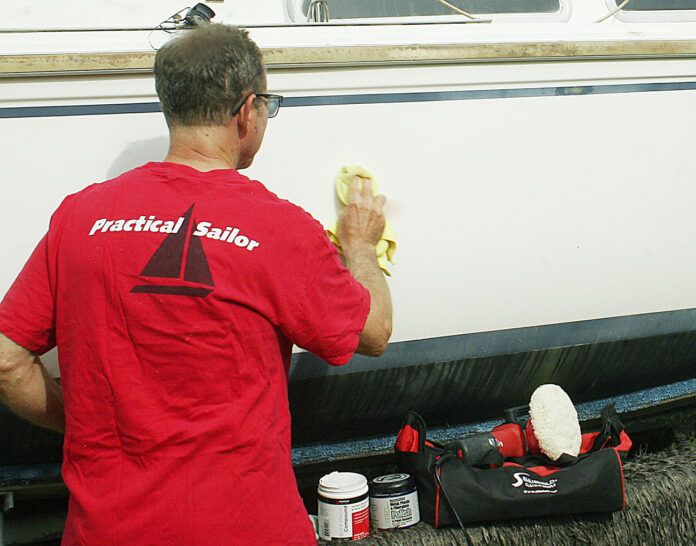With spring launch day looming for most of us, I am plunging once again into polishing and waxing fiberglass boat hulls. This post covers almost everything you need to know about cleaning, polishing, and waxing your boat. It includes links to our online “how-to” resources and links to our tests of various classes of products mentioned. The main purpose of the article is to provide an overview of the many archive articles we have in our library on this topic, so that you can choose which reports best apply to your situation and then dig in as deep as you like.
Most of these articles can be found by using the advanced search function at Practical Sailor or by using Google search and entering “Practical Sailor WAX” or the “Practical Sailor GELCOAT” or “Practical Sailor POLISH.” If you’re serious about protecting your investment and prefer to have all our research in one, easy-to-access eBook, then check out Marine Cleaners: The Complete Series.
There are several ways to attack the buff-and-wax ritual, and I would not say there is one right way for everyone. However, some approaches do get better results than others. I would categorize the types of wax jobs like this:
1) The quick-and-dirty boat wax job, for the full-time cruiser who just wants to protect the boat’s gelcoat from further degradation, prevent gelcoat stains, and make boat-cleaning jobs easier.
2) The perfectionist wax job, for the sailor who wants all of the above, plus wants the boat to look its glossy-best.
3) The in-between wax job, for the sailor who wants his boat to look good, but not at the expense of adding an extra day to his haulout or lay-days.
And certainly, the condition of the boat has a big impact on how you approach the project. If you’re bringing a boat back from the dead, the quick-and-dirty wax job is not really an option (although some makers of “miracle products” would lead you to think differently). You must be prepared to put in some elbow grease.
No matter which category you are in, your waxing job will have three basic steps:
1) Cleaning: This includes getting rid of salt, dirt, grease, mold, stains. You could break this down into various stages, depending on the condition of the hull, general cleaning and stain removal.
2) Polishing: This creates the smooth glossy surface to be protected. If you have an old hull, there could be several stages to this process. We recently tested a boxful of polishes, and I offered some tips in a recent blog post on polishing.
3) Waxing: This is the application of a thin polymer or natural wax coating to seal and protect your polished gelcoat.
The important thing to remember is that if your hull is not clean before you begin polishing or waxing, you might drive dirt further into the pores of the gelcoat. Not the end of the world, but you won’t get the best results.









































